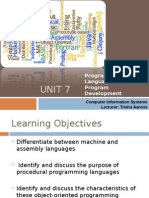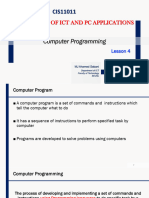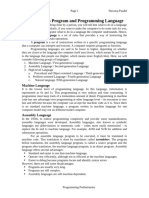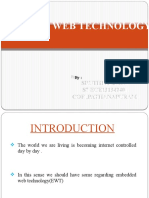Information Technology INT1001: Programming Languages
Uploaded by
romariobartleyInformation Technology INT1001: Programming Languages
Uploaded by
romariobartleyInformation Technology INT1001
Lecture 9 Programming Languages
1
Computers Are Your Future
Tenth Edition
Chapter 11: Programming Languages & Program Development
Copyright 2009 Pearson Education, Inc. Publishing as Prentice Hall
Programming Language & Program Development
Copyright 2009 Pearson Education, Inc. Publishing as Prentice Hall
Development of Program Languages
Programming is the creation of software applications. Programmers are the people who create the software applications. A programming language is a language used by programmers to create programs or software that the computer understands.
Copyright 2009 Pearson Education, Inc. Publishing as Prentice Hall 4
Development of Program Languages
Syntax is the vocabulary and grammar of a programming language. Code is the programming instructions created by the programmers. Source code, the only form of code that humans can read, is program code in its original form.
Copyright 2009 Pearson Education, Inc. Publishing as Prentice Hall
Development of Program Languages
Copyright 2009 Pearson Education, Inc. Publishing as Prentice Hall
Development of Program Languages
There are five distinct programming language generations, or levels:
Machine language Assembly language Procedural languages Nonprocedural languages Natural languages
Copyright 2009 Pearson Education, Inc. Publishing as Prentice Hall
Development of Program Languages
Machine language
First-generation language Based on binary numbers The only programming language a computer understands directly
Copyright 2009 Pearson Education, Inc. Publishing as Prentice Hall
Development of Program Languages
Assembly language
A low-level, second-generation language Requires programming individual instructions for each task to be performed by the microprocessor Mnemonics
Uses brief abbreviations for program instructions Makes language easier to use than machine language
9
Copyright 2009 Pearson Education, Inc. Publishing as Prentice Hall
Development of Program Languages
Procedural languages
Third-generation languages Considered high-level languages Do not require programmers to know details relating to the processing of data Easier to read, write, and maintain
Copyright 2009 Pearson Education, Inc. Publishing as Prentice Hall
10
Development of Program Languages
Two utility programs that translate code so that the computer can interpret and run programs are:
Compilers
Translate source code into object code Translate source code and execute instructions
Interpreters
Copyright 2009 Pearson Education, Inc. Publishing as Prentice Hall
11
Development of Program Languages
Categories of Procedural Language
Structured programming languages
A solution to spaghetti code
Lots of GOTO statements Difficult to follow and prone to errors
A set of standards to make programs more readable, reliable, and maintainable
Copyright 2009 Pearson Education, Inc. Publishing as Prentice Hall
12
Development of Program Languages
Categories of Procedural Language (continued)
Modular programming languages
Divide programs into self-contained modules Use information hiding: keeping information about one module secret from authors of other modules
Copyright 2009 Pearson Education, Inc. Publishing as Prentice Hall
13
Development of Program Languages
Nonprocedural languages
Fourth-generation languages
Report generators (database reports) Query languages Doesnt require programmers to deal with stepby-step procedures to achieve the appropriate programming outcome
SQL (structured query language)
Copyright 2009 Pearson Education, Inc. Publishing as Prentice Hall
14
Development of Program Languages
Natural language
Fifth-generation languages Still being perfected Nonprocedural Use everyday language to program
Copyright 2009 Pearson Education, Inc. Publishing as Prentice Hall
15
A Guide to Programming Languages: One Size Doesnt Fit All
Programmers must select the programming language that can best meets the users needs. Two programming languages that have been used since the 1950s are:
COBOL (Common Business-Oriented Language) for business applications Fortran (formula translator) for scientific/math/engineering applications
Copyright 2009 Pearson Education, Inc. Publishing as Prentice Hall
16
A Guide to Programming Languages: One Size Doesnt Fit All
Structured and modular languages
Required for large-scale program development Examples
Ada BASIC Visual Basic Pascal C
17
Copyright 2009 Pearson Education, Inc. Publishing as Prentice Hall
A Guide to Programming Languages: One Size Doesnt Fit All
Object-oriented languages
Provide easier programming techniques Examples
Smalltalk C++ Java Visual Basic.NET
Copyright 2009 Pearson Education, Inc. Publishing as Prentice Hall
18
A Guide to Programming Languages: One Size Doesnt Fit All
Web-based languages
Not considered programming languages Enable the interpretation of both text and objects by browsers Two types:
Markup languages Scripting languages
Copyright 2009 Pearson Education, Inc. Publishing as Prentice Hall
19
A Guide to Programming Languages: One Size Doesnt Fit All
Markup languages
Define text structure through a set of instructions that are identified with tags. Content lies between tags.
Copyright 2009 Pearson Education, Inc. Publishing as Prentice Hall
20
A Guide to Programming Languages: One Size Doesnt Fit All
Types of markup languages include:
HTML (Hypertext Markup Language) XML (Extensible Markup Language) XHTML (eXtensible Hypertext Markup Language
Copyright 2009 Pearson Education, Inc. Publishing as Prentice Hall
21
A Guide to Programming Languages: One Size Doesnt Fit All
Scripting languages
Use basic programs called scripts to control Web page actions or responses VBScript JavaScript Visual Studio.NET
Types of scripting languages include:
Copyright 2009 Pearson Education, Inc. Publishing as Prentice Hall
22
The Program Development Life Cycle
Program development life cycle (PDLC)
Used to overcome debugging and maintenance problems Made up of six phases, from problem definition through program implementation and maintenance
Copyright 2009 Pearson Education, Inc. Publishing as Prentice Hall
23
The Program Development Life Cycle
Copyright 2009 Pearson Education, Inc. Publishing as Prentice Hall
24
What Youve Learned
A programming language, which is made up of its own vocabulary and syntax, creates instructions that a computer understands. Machine language is based on binary code. Assembly language is similar but a little easier to understand than machine language. Both are difficult and demanding compared to later languages.
Copyright 2009 Pearson Education, Inc. Publishing as Prentice Hall 25
What Youve Learned
Unlike machine and assembly languages, third-generation (high-level) programming languages do not require programmers to have a thorough understanding of processor details. Fourth-generation languages, although even easier for programmers to use, are mostly restricted to accessing databases.
Copyright 2009 Pearson Education, Inc. Publishing as Prentice Hall 26
What Youve Learned
Object-oriented programming languages work with prebuilt objects for fast, even simpler programming when compared to earlier-generation languages. The program development life cycle (PDLC) minimizes errors and maintenance problems.
Copyright 2009 Pearson Education, Inc. Publishing as Prentice Hall 27
What Youve Learned
The six phases of the program development life cycle (PDLC) are (1) defining the problem, (2) designing the program, (3) coding the program, (4) testing and debugging the program, (5) documenting the program, and (6) implementing and maintaining the program.
Copyright 2009 Pearson Education, Inc. Publishing as Prentice Hall 28
What Youve Learned
Debugging and maintaining programs using top-down program design are simpler because program functions are divided into separate modules. Algorithms to perform any processing task can be created by programmers using sequence, selection, and repetition control structures.
Copyright 2009 Pearson Education, Inc. Publishing as Prentice Hall 29
What Youve Learned
There are two types of bugs: syntax errors, which are errors caused by faulty command structure, and logic errors, which are errors caused by faulty programming design.
Copyright 2009 Pearson Education, Inc. Publishing as Prentice Hall
30
You might also like
- Terrence W. Pratt, Marvin V. Zelkowitz-Programming Languages - Design and Implementation-Pearson (2000) PDFNo ratings yetTerrence W. Pratt, Marvin V. Zelkowitz-Programming Languages - Design and Implementation-Pearson (2000) PDF668 pages
- C Programming For Beginners: The Simple Guide to Learning C Programming Language Fast!From EverandC Programming For Beginners: The Simple Guide to Learning C Programming Language Fast!5/5 (1)
- Tutorial PLC Siemens S7 1200 Web ServiceNo ratings yetTutorial PLC Siemens S7 1200 Web Service26 pages
- Computers Are Your Future: © 2005 Prentice Hall, IncNo ratings yetComputers Are Your Future: © 2005 Prentice Hall, Inc40 pages
- Lect 2. Introduction To Programming LanguagesNo ratings yetLect 2. Introduction To Programming Languages3 pages
- Programming Languages and Program Development100% (1)Programming Languages and Program Development50 pages
- Presentation OF: Information and Communication TechnologyNo ratings yetPresentation OF: Information and Communication Technology33 pages
- Chapter One: Introduction To Computers, Programs, and JavaNo ratings yetChapter One: Introduction To Computers, Programs, and Java49 pages
- Object Oriented Programming (OOP) : Chapter OneNo ratings yetObject Oriented Programming (OOP) : Chapter One46 pages
- Languages and Compilers (Sprog Og Oversættere) : Bent Thomsen Department of Computer Science Aalborg UniversityNo ratings yetLanguages and Compilers (Sprog Og Oversættere) : Bent Thomsen Department of Computer Science Aalborg University41 pages
- Introduction to Structured Programming 8th FebNo ratings yetIntroduction to Structured Programming 8th Feb51 pages
- The Evolution and Future of Programming LanguagesNo ratings yetThe Evolution and Future of Programming Languages13 pages
- Programming Languages: Foundations of Computer Science à Cengage LearningNo ratings yetProgramming Languages: Foundations of Computer Science à Cengage Learning11 pages
- Generations of Programming Languages - and Thier UseNo ratings yetGenerations of Programming Languages - and Thier Use4 pages
- Programing Paradigms PPT - 01. 04. 2023No ratings yetPrograming Paradigms PPT - 01. 04. 202354 pages
- Module 1 - Background Concepts Lecture NotesNo ratings yetModule 1 - Background Concepts Lecture Notes35 pages
- Chapter 1-Introduction To Computer Programming100% (1)Chapter 1-Introduction To Computer Programming26 pages
- Sushma Jaiswal-Intro. To Programming MethodologyNo ratings yetSushma Jaiswal-Intro. To Programming Methodology129 pages
- BE EE-EC BCE Programming Languages Pratibha SarafNo ratings yetBE EE-EC BCE Programming Languages Pratibha Saraf4 pages
- Lecture 22-W11-Programming Languages Part 2No ratings yetLecture 22-W11-Programming Languages Part 229 pages
- Introduction To Program Logic FormulationNo ratings yetIntroduction To Program Logic Formulation39 pages
- C Programming: C Programming Language for beginners, teaching you how to learn to code in C fast!From EverandC Programming: C Programming Language for beginners, teaching you how to learn to code in C fast!No ratings yet
- COMPUTER PROGRAMMING FOR KIDS: An Easy Step-by-Step Guide For Young Programmers To Learn Coding Skills (2022 Crash Course for Newbies)From EverandCOMPUTER PROGRAMMING FOR KIDS: An Easy Step-by-Step Guide For Young Programmers To Learn Coding Skills (2022 Crash Course for Newbies)No ratings yet
- Evaluating IndexedDB Performance On Web Browsers100% (1)Evaluating IndexedDB Performance On Web Browsers7 pages
- Creating Database Reports: Guide To Oracle 10gNo ratings yetCreating Database Reports: Guide To Oracle 10g89 pages
- Introduction To Visual Studio and CSharpNo ratings yetIntroduction To Visual Studio and CSharp48 pages
- 21cap062 Chat Application Journal UpdateNo ratings yet21cap062 Chat Application Journal Update5 pages
- UI Redressing: Attacks and Countermeasures Revisited: Marcus Niemietz Marcus - Niemietz@rub - deNo ratings yetUI Redressing: Attacks and Countermeasures Revisited: Marcus Niemietz Marcus - Niemietz@rub - de45 pages
- (Ebook) Digital Media and Innovation; Management and Design Strategies in Communication; Second Edition by Richard A. Gershon ISBN 9781003294375, 1003294375 2024 scribd download100% (4)(Ebook) Digital Media and Innovation; Management and Design Strategies in Communication; Second Edition by Richard A. Gershon ISBN 9781003294375, 1003294375 2024 scribd download51 pages
- Web Technology Notes Btech Csvtu 6th SemNo ratings yetWeb Technology Notes Btech Csvtu 6th Sem16 pages































































































